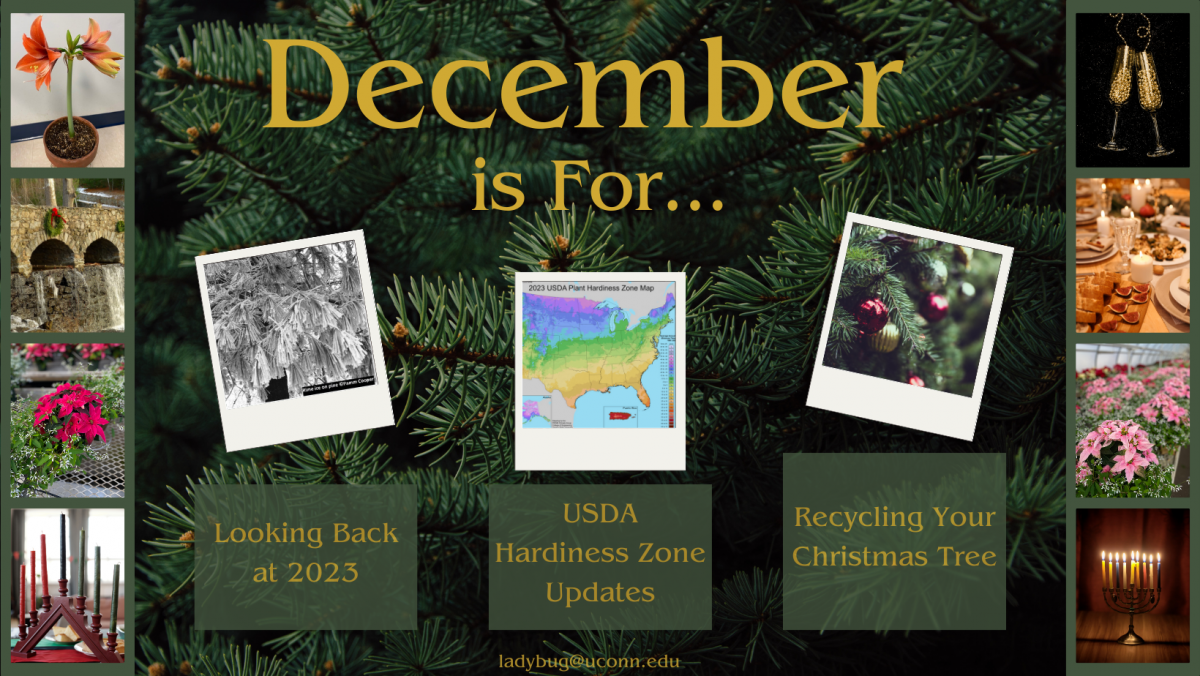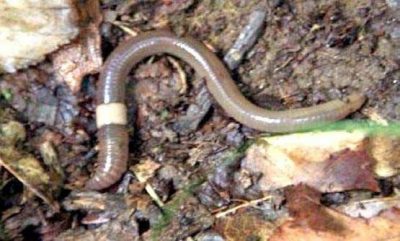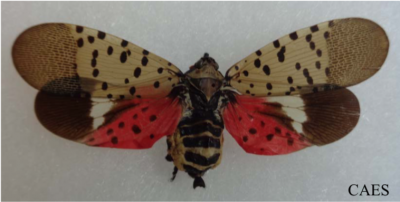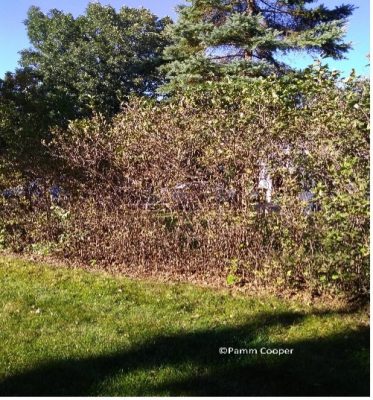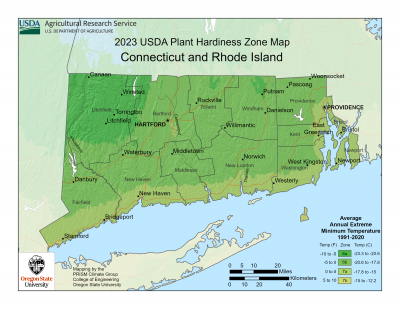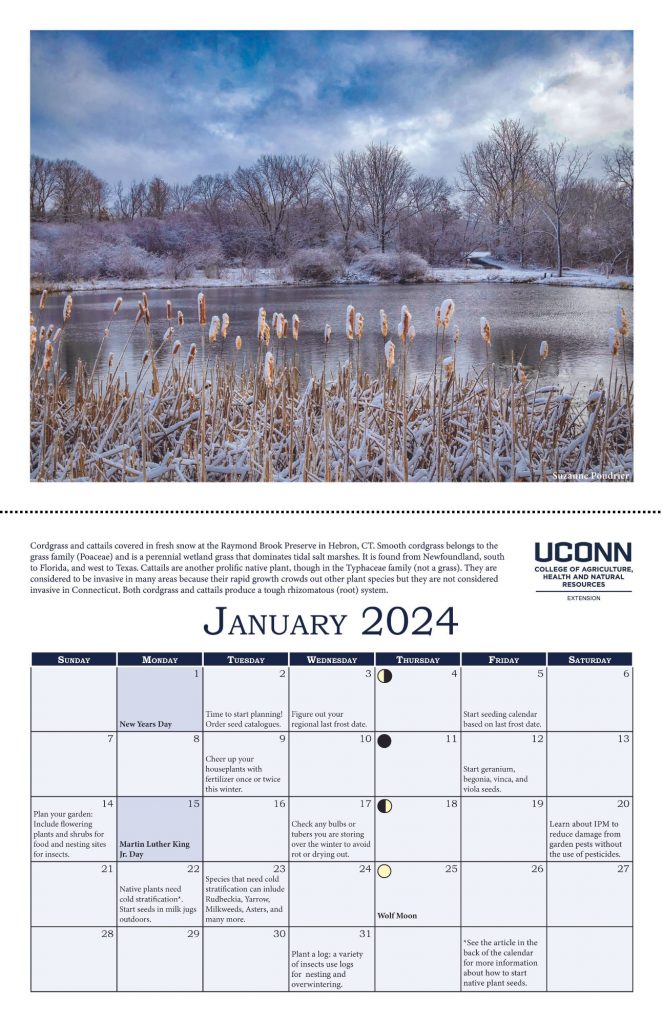Looking Back at 2023
This year we saw some spectacular sights in our gardens, yards, and environment! We saw historic flooding and wildfire smoke in our air. Some of you also noticed bumper crops of acorns, strange timing of veggie crops, and hungry bunnies going after your plants.
In our newsletter this month, we're highlighting some of the most interesting sights we saw and answered questions about!

Exobasidium vaccinii Azalea Galls
A familiar gall to those who see them on the native Pinxter azaleas, this year they were widespread in Connecticut on older Rhododendron and azalea shrubs. These are leaf galls and are very heavy and succulent to juicy when cut in half. Twigs containing galls should be pruned off just below the gall before white spore surface appears.

Maple Anthracnose
Maple Anthracnose caused early leaf drop on many native maples. Continued wet weather caused many fungal outbreaks on our plants this year with sugar and red maples having severe anthracnose outbreaks causing brown shriveled leaves as early as August. A drier year in 2024 may avert any recurrence, especially if leaves were raked up and removed.
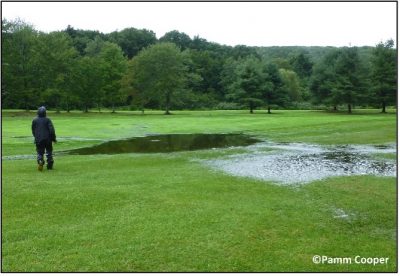
Flooding
This could have been the year of the fish, with many rainfall events that had inches of rain at a time. The Connecticut River flooded and acres of crops were taken out by standing water. Once edible crops have been flooded by rivers, crops are not suitable for human consumption, and farmers without insurance for this type of event suffer economically. To avoid compaction, gardens and lawns should not be worked in or walked on until surface water has infiltrated into the ground or evaporated from the soil surface. Vegetable gardens affected by floodwater generally have other issues, especially those concerning food safety.
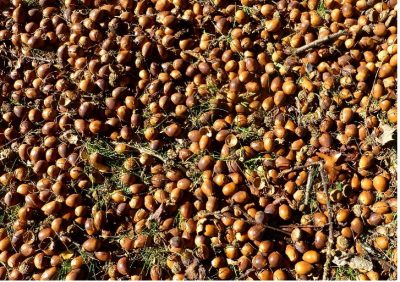
Notice a Lot of Acorns, Fruits and Pinecones?
This year was a mast year for many species of woody plants like white pines, oaks and Eastern Red Cedar Juniperus virginiana. Mast means fruit, and a mast year is when more fruit than normal is produced. Reasons for mast years are not always clearly understood.

The Year of the Rabbit
This was the Chinese Year of the Rabbit, and boy was it ever. Some rabbits eat fallen leaves if they are green and will perhaps stay away from garden plants when they are available. We had many reports from around the state as people noticed larger than normal numbers of rabbits on their property. Many of this year’s crop of bunnies seemed nonplussed by humans, and you may have had to practically push them out of your garden…
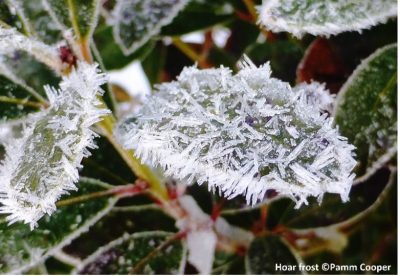
Rime Ice Events in Parts of Connecticut
Rime ice forms quickly when the moisture contained in a winter fog freezes onto an object having colder temperatures. As more moisture droplets from the fog contact these freezing surfaces, this ice can build up, sometimes appearing as feathery frosting rather than as a clear ice. If foggy conditions continue over a few days, rime ice can build up and get heavy, which it did in some areas of Connecticut. When the sun comes out, rime ice can melt quickly.
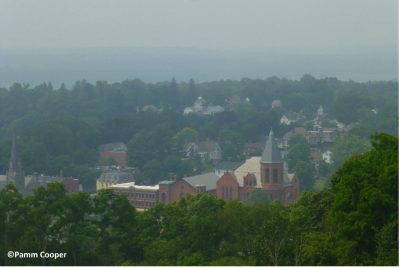
Canadian Wildfires and Ashy Skies
Many perennials that were starting growth spurts in the spring were affected by weeks of hazy skies in May and June caused by wildfire ash from Canadian wildfires mingled with extended cloudy days. Many perennials were noticeably taller than normal as they reached upward for some sun and had difficulty finding adequate amounts of light for lengthy periods. Next year height of plants should be normal. Image is from Vernon, Ct.
Did your Lilacs lose their leaves this year?
Older lilacs that had not been pruned regularly to allow foliage to dry out better may have been affected by a fungal pathogen of a Pseudocercospora spp. Leaves may have turned brown and fallen by the end of summer. If this happened to your lilacs, make sure to remove the leaves from the ground and discard them. Prune if needed to allow better air circulation. With all the rain and humidity this year, lilacs may still have been infected, but next year may be drier with less incidences of this leaf disease.
Christmas Tree Recycling?
Many homes across the country will be celebrating Christmas this year with a live tree. Environmentally conscious gardeners may be wondering if there are other uses for it besides putting it on the street for the town to pick up. "Old" Christmas trees and holiday greens can be used as a shelter and food source for wildlife, compostable organic material, or wood chips. Always remember to remove any wire or decorations from trees and greens before recycling them.
Holiday Food Safety Tips
Dr Indu Upadhyaya from UConn Extension published an article recently about things to keep in mind as you're preparing your holiday meals this season. While this is something the Home & Garden Education Center doesn't have expertise in, UConn has detailed food safety resources for home cooks as they prepare traditional holiday meals this season.
Knowledge to Grow On

Read our Ladybug Blogs, Written Weekly!
Bulbs: The Good, The Bad, And The Ugly
Give Thanks for all the Little Things!
When Should I Clean Up My Garden?
Upcoming Events and Things to Do
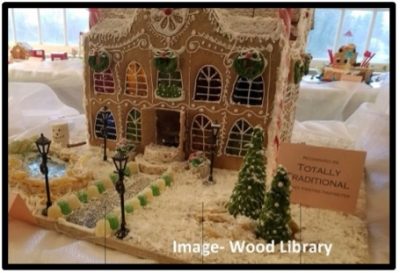
-
The UConn Horticulture Club will be selling poinsettias and a collection of rosemary plants shaped and decorated like miniature Christmas trees. The sale will be on Monday (12/4), Wednesday (12/6), and Friday (12/8) from 2-5 pm each day, in the Floriculture building.
-
It's a great time of year for craft fairs and festive shopping! Check your with your local recreation department for events like Holidays on Main in Wethersfield, CT or the Winter Festival at the Woodstock Fairgrounds.
-
Winterfest Hartford is an opportunity to go ice skating in Bushnell Park! They host free events, including free skating lessons and visits with Santa through the month of December.
-
Twilight Tours at Osbourne Homestead Museum - Museum volunteers transform this historic museum into a festive, holiday showcase!
- Holiday Light Festival & Market in Hartford, CT - Enjoy interactive light gardens, illuminated structures, seasonal food and drinks, family-friendly activities, a festive holiday market and daily live entertainment.
- Winterfest and Tunnel of Lights at the Connecticut Trolley Museum takes guests on an evening trolley ride along with carols and other festivities.
- Visit the Lobster Trap Tree in Stonington, CT - This is the third annual event honoring the rich fishing history in the town of Stonington. Artists paint buoys to hang from the lit tree of lobster traps - quite a sight to see!
- Go Snow tubing, skiing or visit the artisan market at Powder Ridge's Lifted Spirits event in Middlefield, CT
- Celebrate Hanukkah by participating in a community Menorah Lighting
- Wood Library 13th Annual Gingerbread House Festival is one of the largest gingerbread festivals in our region- features replications of historical buildings and other structures. Opens the day after Thanksgiving- December 17th.
- Christmas Bird Count- participate in the annual bird count in your area this year. The Christmas Bird Count occurs December 14 to January 5 every season. Join in the count or sign up to see the results of this annual Christmas season bird species count.
Educational Opportunities and Workshops
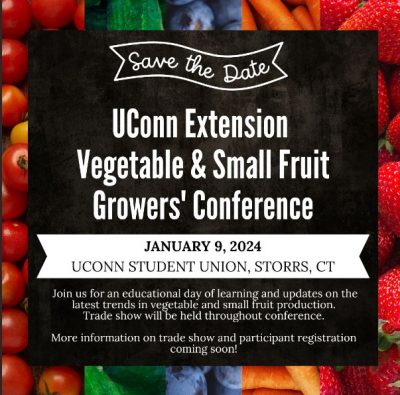
-
Learn to make a Christmas Themed Charcuterie Board with Preston Ridge Vineyard in Preston, CT
- Learn to make a holiday boxwood tree! Our Kids Farm in Canterbury, CT and Lewis Educational Agricultural Farm (LEAF) in Southington, CT are just a couple of many local businesses in the state hosting these build your own boxwood tree events. Check with local small farms, florists and other associations for workshops like this.
- Webinar: Humanity for Habitat hosted by the Ecological Landscape Alliance
- The CT Vegetable & Small Fruit Growers Conference is coming back this January. Early Bird Registration ends December 20th, 2023
Master Gardener Calendar Sale
The UConn Master Gardeners have assembled a calendar for Connecticut gardeners! There are tips through every month on how to plan and maintain your garden for fresh blooms and abundant vegetables. This year there is additional information on supporting beneficial insects in the landscape, with tips on using integrated pest management, creating habitat for beneficials, and starting native plants by seed in the winter. All photos were submitted by local gardeners and selected by MG Volunteers during a statewide photo contest. This makes a great holiday gift for the gardener on your list!
December Gardening Tips
- Rotate windowsill plants a quarter turn each week to give all branches equal exposure to the winter sun.
- Holiday plants, including amaryllis, mistletoe, and yew are toxic and should be kept away from children and pets. Contact Poison Control at 1-800-222-1222 immediately if you suspect a problem.
- Reduced light during the winter can cause houseplants to become dormant. Be careful not to overwater them during this time although they may need to be watered more often when the heating system is on.
- Harvest any leeks and root vegetables such as carrots and parsnips that are still in the garden
- Mark perennials and bulbs before they become covered in snow to help you identify plants in early spring.
- Avoid using salt to melt ice on driveways and sidewalks which may end up on the lawn, when possible, use sand or kitty litter. This will help prevent salt damage to plant roots.
- Tap the evergreen branches gently to remove snow and ice to prevent the branches from breaking.
- Be sure to keep bird feeders stocked with seed and suet for the winter months.
- If you have friends or family that like to garden, think of gardening gifts for the holidays. Books, gloves, hand tools, weather instruments, and fancy pots are some fun ideas to consider.
- Turn compost piles one more time before they freeze for the winter.
Photo Op: Fascinating Sights
See something cool in your garden? Send your pictures to us at ladybug@uconn.edu with subject line “Newsletter Photo” and a brief caption to be considered for next month’s highlight!

Rainbow Over Connecticut River by Elizabeth Merkt

This Month’s Newsletter Contributors:
Pamm Cooper, Dr. Nick Goltz, Dawn Pettinelli, Marie Woodward, Heather Zidack
